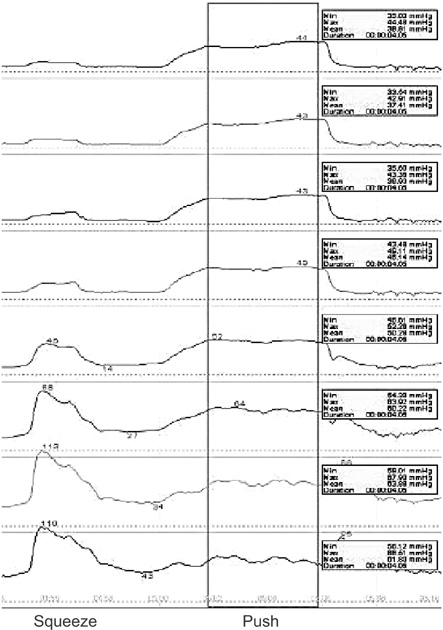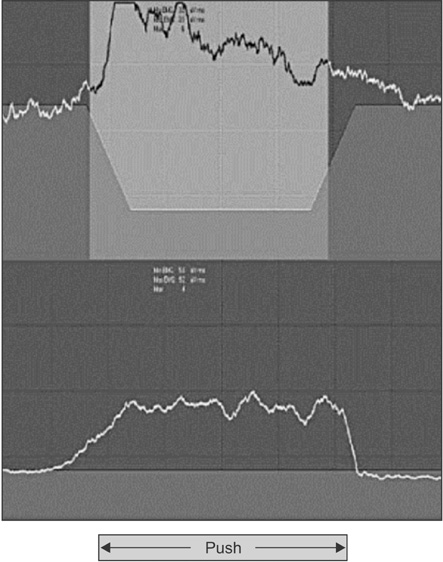Ann Surg Treat Res.
2016 Feb;90(2):89-94. 10.4174/astr.2016.90.2.89.
Clinical utility of balloon expulsion test for functional defecation disorders
- Affiliations
-
- 1Department of Surgery, Konkuk University School of Medicine, Seoul, Korea. recto@kuh.ac.kr
- KMID: 2166827
- DOI: http://doi.org/10.4174/astr.2016.90.2.89
Abstract
- PURPOSE
I investigated the diagnostic accuracy of balloon expulsion test (BET) with various techniques to find out the most appropriate method, and tried to confirm its clinical utility in diagnosing functional defecation disorders (FDD) in constipated patients.
METHODS
Eighty-seven patients constituted the study population. FDD was defined when patients had at least two positive findings in defecography, manometry, and electromyography. BET was done 4 times in each patient with 2 different positions and 2 different volumes. The positions were seated position (SP) and left lateral decubitus position (LDP). The volumes were fixed volume (FV) of 60 mL and individualized volume with which patient felt a constant desire to defecate (CDV). The results of BETs with 4 different settings (LDP-FV, LDP-CDV, SP-FV, and SP-CDV) were statistically compared and analyzed.
RESULTS
Of 87 patients, 23 patients (26.4%) had at least two positive findings in 3 tests and thus were diagnosed to have FDD. On receiver operating characteristic curve analysis, area under curve was highest in BET with SP-FV. With a cutoff value of 30 seconds, the specificity of BET with SP-FV was 86.0%, sensitivity was 73.9%, negative predictive value was 89.8%, positive predictive value was 65.4%, and accuracy rate was 82.8% for diagnosing FDD.
CONCLUSION
SP-FV is the most appropriate method for BET. In this setting, BET has a diagnostic accuracy sufficient to identify constipated patients who do not have FDD. Patients with negative results in BET with SP-FV may not need other onerous tests to exclude FDD.
MeSH Terms
Figure
Reference
-
1. Rome Foundation. Rome III disorders and criteria [Internet]. Raleigh (NC): Rome Foundation Inc.;c2015. cited 2015 May 10. Available from: http://www.romecriteria.org/criteria.2. Seong MK, Kim TW. Significance of defecographic parameters in diagnosing pelvic floor dyssynergia. J Korean Surg Soc. 2013; 84:225–230.3. Rao SS. Dyssynergic defecation. Gastroenterol Clin North Am. 2001; 30:97–114.4. Minguez M, Herreros B, Sanchiz V, Hernandez V, Almela P, Anon R, et al. Predictive value of the balloon expulsion test for excluding the diagnosis of pelvic floor dyssynergia in constipation. Gastroenterology. 2004; 126:57–62.5. Rao SS, Mudipalli RS, Stessman M, Zimmerman B. Investigation of the utility of colorectal function tests and Rome II criteria in dyssynergic defecation (Anismus). Neurogastroenterol Motil. 2004; 16:589–596.6. Rao SS, Ozturk R, Laine L. Clinical utility of diagnostic tests for constipation in adults: a systematic review. Am J Gastroenterol. 2005; 100:1605–1615.7. Bannister JJ, Timms JM, Barfield LJ, Donnelly TC, Read NW. Physiological studies in young women with chronic constipation. Int J Colorectal Dis. 1986; 1:175–182.8. Pelsang RE, Rao SS, Welcher K. FECOM: a new artificial stool for evaluating defecation. Am J Gastroenterol. 1999; 94:183–186.9. Barnes PR, Lennard-Jones JE. Balloon expulsion from the rectum in constipation of different types. Gut. 1985; 26:1049–1052.10. Ratuapli S, Bharucha AE, Harvey D, Zinsmeister AR. Comparison of rectal balloon expulsion test in seated and left lateral positions. Neurogastroenterol Motil. 2013; 25:e813–e820.11. Rao SS, Singh S. Clinical utility of colonic and anorectal manometry in chronic constipation. J Clin Gastroenterol. 2010; 44:597–609.12. Belkind-Gerson J, Goldstein AM, Kuo B. Balloon expulsion test as a screen for outlet obstruction in children with chronic constipation. J Pediatr Gastroenterol Nutr. 2013; 56:23–26.13. Chiarioni G, Kim SM, Vantini I, Whitehead WE. Validation of the balloon evacuation test: reproducibility and agreement with findings from anorectal manometry and electromyography. Clin Gastroenterol Hepatol. 2014; 12:2049–2054.14. Diamant NE, Kamm MA, Wald A, Whitehead WE. AGA technical review on anorectal testing techniques. Gastroenterology. 1999; 116:735–760.15. Dedeli O, Turan I, Ozturk R, Bor S. Normative values of the balloon expulsion test in healthy adults. Turk J Gastroenterol. 2007; 18:177–181.
- Full Text Links
- Actions
-
Cited
- CITED
-
- Close
- Share
- Similar articles
-
- How to Perform and Interpret Balloon Expulsion Test
- Balloon Expulsion Test and Perineometry as a Screening Test in the Diagnosis of Spastic Pelvic Floor Syndrome
- A Study of the Effect of Changes in Ano-Rectal Function after Hysterectomy
- Balloon Expulsion Test Does Not Seem to Be Useful for Screening or Exclusion of Dyssynergic Defecation as a Single Test
- Classification and Treatment of Constipation




